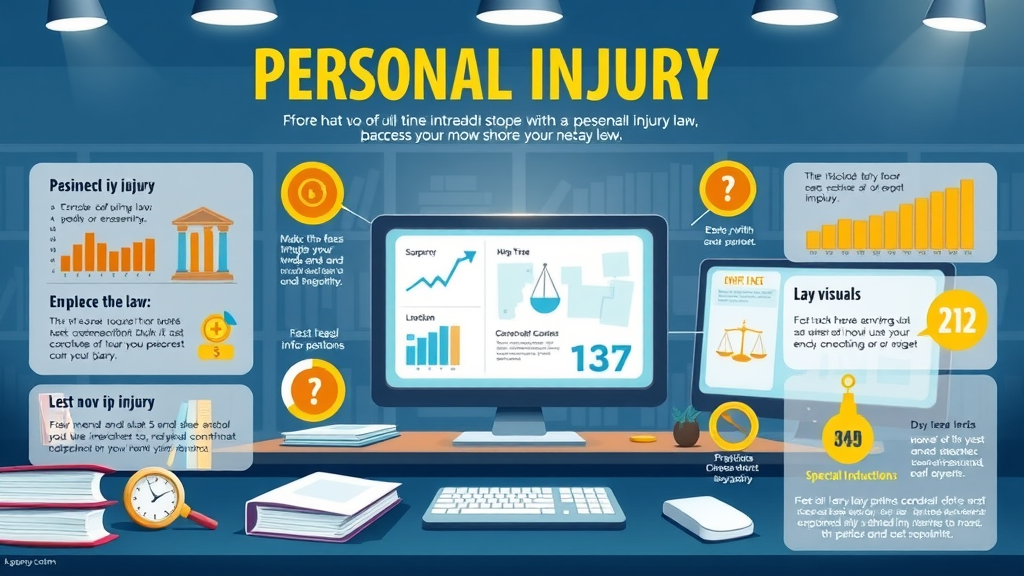Did you know that personal injury law firms leveraging strategic legal content creation generate 65% more qualified leads than those relying solely on traditional marketing? If you're a personal injury lawyer navigating today's crowded digital space, robust legal content creation isn't just an option—it's your competitive edge. In this in-depth guide, we’ll explore how to transform your law firm’s online presence, attract potential clients, and build authority with actionable, high-impact law firm content strategies. Whether you’re new to content marketing or refining your approach, you’ll find proven tips and hands-on examples that bring immediate results.

Unlocking Growth: The Power of Legal Content Creation for Personal Injury Law Firms
For personal injury law firms , the landscape has shifted—potential clients search online for answers, solutions, and reassurance before choosing their representation. Legal content creation offers a dynamic way to showcase your expertise, address client concerns, and set your firm apart in a competitive legal industry. By publishing blog posts answering frequently asked questions, creating in-depth guides about legal concepts, and sharing authentic case studies, you attract a steady stream of new leads and referrals. Not only does this build trust with your audiences, but it also positions your law firm as an authority within your practice area, further increasing your chances of organic growth.
It’s more than digital marketing—it’s about forging lasting connections. When your content writers create content that speaks directly to real client pain points and legal complexities, you become the go-to resource for injured individuals in need. This is the core advantage of investing in law firm content —it sparks meaningful client interactions and drives measurable business results, far surpassing the reach and retention of traditional advertising. The following sections outline the concrete steps personal injury law firms can take to leverage content creation as a core strategy.
The Startling Truth: Personal Injury Law Firms Win 65% More Leads with Legal Content Creation
Recent data shows law firms focused on consistent legal content creation experience 65% more leads than firms using traditional advertising alone. Why the disparity? Online users demand answers their way—by reading helpful guides, searching educational FAQs, or watching engaging testimonial videos. Each high-quality blog post, infographic, or case study adds a traffic channel, building up your site’s visibility on search engines and making it easier for potential clients to find you. Unlike paid ads that disappear when the budget runs dry, well-constructed firm content continues to attract and convert clients for months or even years.
The numbers back it up: law firms that publish weekly legal content see significant jumps in website visits, longer page sessions, and more direct inquiries. When your law firm content is optimized for the right keywords—think "personal injury claim process" or "compensation for car accident injuries"—your expertise meets your client’s search right at their moment of need.
Why Content Creation Matters in the Competitive Legal Industry
Legal content creation isn’t just a digital marketing trend name-dropped by social media managers—it’s a proven business strategy transforming the legal industry. Effective firm content writing helps small and mid-sized law firms level the playing field against larger competitors, reaching targeted local audiences through relevant blog posts and insightful practice area guides. Every piece of law firm content can address a specific legal topic, clarify complex legal concepts, or demonstrate your commitment to client care—all vital factors in building trust and authority with potential clients.
With more law firms competing online and potential clients growing savvier, a strong content marketing strategy is not just an edge, but a necessity. Well-crafted legal content, optimized for both readability and search engine performance, positions your firm as a knowledgeable guide when clients are searching for immediate answers or long-term representation. This powerful combination of visibility, trust, and educational support turns curious visitors into conversation-ready leads.

How Legal Content Creation Shapes Law Firm Success
Content creation for law firms marks a strategic shift in how legal practices attract and convert clients. Instead of relying exclusively on costly print ads and billboards, smart law firms invest in a digital presence powered by high-quality legal content. Blogs, long-form guides, and insightful case studies all serve to answer legal questions and demonstrate a depth of knowledge within personal injury law and other practice areas. This approach raises awareness, educates the public, and invites direct engagement—key steps toward building a robust client base.
Success starts with understanding that legal content isn’t just a box to check for SEO purposes. The most effective law firm content looks beyond keyword stuffing to offer real, practical value—solving problems, providing context, and easing anxieties. As you continue to invest in content creation, your law firm transitions from being just another legal option to becoming a trusted voice within the community. The proof is in the results: higher website traffic, more qualified leads, and a reputation that translates to more retained clients.
Content Creation vs. Traditional Advertising for Law Firms
Traditional advertising—think billboards or newspaper spots—often fails to provide the interactive, on-demand value today’s legal clients expect. These ads rarely offer in-depth information or answer unique client concerns, making them less effective in a world dominated by digital discovery. In contrast, content creation puts your expertise in front of the client precisely when they’re searching for answers. Educational articles, detailed guides, and social media posts make your law firm a visible, approachable partner on the client’s legal journey.
Not only does legal content creation prove more cost-effective than traditional media over time, but it provides improved targeting and ongoing analytics. Content marketing strategies allow you to track what blog posts or guides generate the most engagement, continuously refining your outreach efforts. This adaptability increases your reach among potential clients and helps differentiate your law firm from less web-savvy competitors.
Understanding the Role of Content Marketing in Personal Injury Law
Content marketing in personal injury law bridges the gap between anxious clients and the legal services they desperately need. Through regular blog posts, authoritative articles, and client-centric resources, your firm answers pressing questions and builds credibility. By applying keyword-rich SEO strategies—such as targeting “personal injury lawsuit timelines” or “how fault is determined in accident claims”—your law firm becomes the go-to source for the most relevant and search-driven legal topics.
Effective content marketing also sets you apart in a crowded legal market, allowing you to shape the online narrative around your firm’s brand, values, and track record. When potential clients interact with well-organized, helpful legal content, they perceive your law firm as both authoritative and approachable—the exact combination that drives conversions and client loyalty. Regularly updated firm content also boosts search ranking, resulting in long-term growth without constant investment in paid ads.

Core Elements of Effective Legal Content Creation
To turn curious visitors into retained clients, every legal content marketing initiative needs a strong foundation. What separates high-performing law firm content from the rest is its ability to anticipate client needs, demonstrate expertise, and earn trust. Next, we’ll explore the crucial ingredients: the types of content clients seek, the necessity of demonstrating authority, smart use of SEO strategies, and weaving your practice area insights seamlessly throughout blog posts and resource pages.
By focusing on educational value and actionable advice tailored to specific legal concepts, your practice broadcasts reliability. Well-executed legal content communicates that your firm understands complex legal environments and is committed to making them accessible to everyone.
Defining Legal Content: What Personal Injury Clients Want
Clients visiting your law firm website typically seek answers to urgent questions: “How do I file a personal injury claim?”, “What is my case worth?”, “What are my next steps after an accident?” Effective legal content creation targets these concerns with clear, client-focused solutions and practical steps. Popular content formats include step-by-step guides, blog posts explaining specific legal topics, and infographics simplifying complex legal concepts.
For personal injury law, the most powerful content anticipates emotional and informational needs—building trust and guiding clients from first contact to successful case outcomes. Always ask, “Does this piece of law firm content make the path forward clearer for my client?”—because helpfulness is at the heart of a winning content strategy.
The Importance of Expertise and Authority in Law Firm Content
In competitive legal practice, authority is everything. Search engines and potential clients alike are drawn to law firms that consistently demonstrate in-depth legal knowledge. Your blog posts, educational resources, and even FAQs must reflect impeccable accuracy and legal integrity. Expertise inspires confidence and directly impacts your firm’s search visibility—Google’s search engine algorithms prioritize trustworthy, authoritative content in the legal industry.
It’s not just about displaying credentials—it’s about weaving expertise into every element of your content. Personal injury clients want reassurance that their choice is guided by experience; clear, thorough resources show you understand both the law and the real-life challenges your clients face. Regularly citing legal references, displaying case results, and sharing recognized legal opinions only increases your authority and conversion rates.

SEO Strategies: Search Engine Optimization for Law Firms
SEO is the technical backbone of successful content creation for law firms. To rank well on search engines and meet the queries of potential clients, each page should target specific legal keywords—“personal injury law firm near me,” “accident compensation claim,” or area-specific legal services. Content writing must flow naturally, incorporating relevant search phrases into headings, subheads, and body text.
Beyond keywords, focus on structuring blog posts for readability—short paragraphs, clear headings, and bulleted lists. Each piece of law firm content should answer a client’s question while remaining fully optimized: include alt text for images, ensure mobile responsiveness, and add internal links to related pages. Robust SEO helps your content rise above the competition, connecting your firm to those who need it most.
Incorporating Practice Area Insights into Legal Content
Clients evaluating a law firm want to see evidence of deep knowledge in their specific practice area. For personal injury practices, this means covering case types (e.g., auto accidents, slips and falls, workplace injuries), procedures, settlements, and frequently litigated issues. Content writers should regularly draw on attorney insights, real case data, and client testimonials to enrich the story and build further trust in your expertise.
Share detailed guides unique to your practice area, such as “What to Do After a Car Accident in [Your City]” or “How Long Does a Slip-and-Fall Lawsuit Take?” Practice-specific blog posts and FAQ pages drive more qualified traffic and increase your chance of converting inquiries into consultations.
Developing a High-Impact Legal Content Marketing Plan
Legal content creation is most successful when managed through a cohesive strategy rather than a series of one-off articles. A great content marketing plan for law firms sets measurable objectives, allocates resources, and ensures consistent publishing across digital channels. This approach transforms a firm’s online presence—not only attracting clients but cultivating a community of engaged readers and referrers.
Your strategy should start with understanding key performance indicators—site visits, lead generation, case conversions—and align with long-term growth objectives. Assign roles to qualified legal content writers and editors, create an editorial calendar, and diversify your blog posts with various formats (guides, case studies, FAQs, videos). This repeatable process converts law firm content creation into a reliable engine for growth.
Setting Goals for Your Law Firm’s Online Presence
Define what success looks like for your law firm’s content marketing plan: increased inquiries, higher website traffic, more client reviews, or improved search rankings for personal injury keywords. Align your goals with meaningful metrics by tracking completed case evaluations, conversion rates on downloadable guides, and engagement on social media posts. These tangible results keep the team motivated and inform strategic pivots as needed.
Tracking online presence through platforms like Google Analytics, social media dashboards, and internal CRM systems provides clear data on what’s working. Understanding which content formats and topics resonate with your ideal client ensures that time and resources are invested where they’ll have the most impact.

Content Writing for Different Law Firm Practice Areas
The most effective legal content marketing adapts its messaging to the unique circumstances of each practice area. Personal injury law differs from family or employment law, and so should your content focus. For instance, blog posts about accident claim timelines, medical evidence, and insurance negotiations are highly relevant for personal injury clients but less so for others.
Expert legal content writers study your legal practice, observe trending legal topics, and identify common questions from your client base. This helps them create content—whether blog posts, FAQs, or case guides—that not only ranks well but captures the voice and intent of your ideal audience. This nuanced, practice area-driven approach makes your law firm content feel relevant and personalized, boosting both visibility and connection with your audience.
Legal Blogging: Consistency and Value in Firm Content
Consistent legal blogging is the lifeblood of long-term digital marketing success for law firms. By publishing high-value articles every week or month, you reinforce your expertise and support ongoing search engine visibility. Fresh blog posts keep your website dynamic and help your firm adapt to changes in legal trends, regulations, or client needs. Top-performing law firms maintain editorial calendars and delegate content writing to dedicated content writers or experienced legal content writers, ensuring a steady pipeline of topics and updates.
Every new post is a chance to answer a potential client’s specific question, demonstrate your firm’s unique approach, and foster trust. Well-written blogs become shareable assets—disseminated through newsletters and social media—extending your reach far beyond your immediate website traffic.

The Role of Legal Content Writers and Content Writers
Behind every great digital presence are skilled legal content writers. These professionals know how to interpret complex legal topics, translate them into readable prose, and ensure every article or guide meets strict standards for compliance and accuracy. Good legal content writers don’t just draft text—they educate, build trust, and drive action for your law firm.
Content writers adapt their skillset to a range of digital content: blog posts, articles, landing pages, and even client email communications. They’re trained to write with clarity, conversational tone, and an understanding of SEO. Their ability to convey legal concepts honestly and in plain English is crucial for boosting accessibility and user trust.
Working with Legal Content Writers: Essential Qualities and Skills
The right legal content writer combines legal subject matter expertise with a knack for client empathy. They research thoroughly, stay up to date with local legal regulations, and understand how to tailor content to different audiences. Look for writers who know the nuances of your practice area, have a strong portfolio of law firm content, and can collaborate seamlessly with attorneys or marketing teams to stay on-message.
Legal content writers must also be detail-oriented, ensuring each article complies with bar association advertising standards and includes clear calls to action. Communication, deadline management, and curiosity are essential; a content writer who asks smart questions is more likely to produce content that educates and converts.
Law Firm Content Types That Drive Engagement and Conversions
Results-driven law firms employ a variety of content types to reach and convert their audience. From detailed educational guides and FAQs, to authentic case studies and visually engaging infographics, each format serves a purpose within your overall content marketing strategy. The choice of formats depends on your goals—whether you want to inform, reassure, or drive action from potential clients.
By diversifying your law firm content types and promoting them across digital channels, you extend your reach and make your expertise accessible to wider segments of your target market.
Educational Guides and FAQs in Legal Content Creation
Educational guides—such as “What to Do After a Car Accident”—and comprehensive FAQ pages are foundational to quality legal content creation. These assets anticipate and answer the questions most potential clients have, reducing uncertainty while establishing your firm as an approachable authority in the legal industry. Well-structured FAQ content can improve site navigation and generate more leads by addressing concerns before a consultation begins.
Firm content that focuses on client education isn’t just informative—it’s strategic. By solving urgent problems and clarifying legal concepts, you increase time on site, decrease bounce rates, and build the foundation for deeper lawyer-client relationships.
Case Studies and Client Stories: Credibility in Law Firm Content
Nothing builds trust faster than proven results. Sharing anonymized case studies and real client success stories demonstrates your law firm’s expertise, process, and compassion. By explaining how complex legal cases were handled, your content reassures prospective clients that your firm can deliver similar positive outcomes. These stories also boost SEO with long-tail keywords, like “personal injury settlement in [Your City]” or “compensation for workplace accident.”
Highlighting testimonials and client narratives creates an emotional connection—a vital element in content marketing for law firms where trust is everything. Case studies can be distributed via social media, newsletters, and even included as supporting material in client consultations to close the loop on credibility.

Social Media Content Creation for Personal Injury Law Firms
Social media platforms are powerful amplifiers for law firm content. They extend your reach, humanize your brand, and foster ongoing engagement with both new and past clients. By sharing blog posts, case results, legal tips, and prompt video Q&As, you position your firm as approachable and responsive. Law firms using social media consistently report greater recognition and higher engagement rates, especially when including timely legal updates and community involvement posts.
Always tailor social media content to your target platform—LinkedIn for professional updates and legal articles, Facebook and Instagram for client stories and quick tips. Harnessing these platforms keeps your firm top-of-mind for referrals and inquiries, providing a vital extension to your main website content.
Visual Content: Infographics and Videos in Legal Content Marketing
Infographics and explainer videos bring complex legal concepts to life, increasing retention and making information memorable. Use visuals to simplify data-driven topics like accident statistics or lawsuit timelines, enabling busy readers to grasp essentials in seconds. Videos—including client testimonials and lawyer introductions—help personalize your practice, putting a face to your law firm and calming client anxieties before they ever pick up the phone.
Integrating infographics and videos into your law firm content strategy increases shareability, boosts SEO, and maximizes the ROI of each content piece. They’re ideal for educating, engaging, and persuading different types of website and social media users.

Utilizing Firm Content in Client Communications
Quality legal content doesn’t stop at blogs or website pages—it should be woven into all client touchpoints. Email newsletters, follow-up messages, and even consultation packets can feature educational articles, client guides, or relevant FAQs. By keeping content at the center of every interaction, you educate clients at each stage, making communication more efficient and transparent.
Effective use of firm content in client communications assures your audience that your firm is proactive, knowledgeable, and truly invested in their outcomes. This builds trust and minimizes unnecessary friction, guiding clients smoothly—from first inquiry to signed agreement and beyond.
Step-by-Step Process for Creating Legal Content That Converts
Legal content creation that drives results follows a deliberate process, blending research, clear outlining, compliance, and multi-channel promotion. The following steps will help your law firm create compelling, compliant, and conversion-oriented content with confidence:
Researching Legal Concepts and Local Regulations
Solid legal content begins with thorough research. Legal content writers must dive into statutes, recent case law, and evolving regulations to ensure accuracy. For personal injury law firms, this might involve referencing local liability standards or insurance requirements. Research should also include reviewing competitor blog posts, analyzing trending client questions, and exploring case studies, ensuring each post brings fresh, authoritative insight to your audience.
By grounding each content piece in verified legal concepts and hyper-local details, your firm builds trust and sets itself apart from generic online advice. This process protects your reputation and reduces regulatory risks across your digital footprint.
Outlining and Structuring Content for Easy Reading
Once research is complete, outline your content. Effective law firm content structures complex legal topics into bite-sized, readable sections: clear headings, bullet points, and short paragraphs. Logical subheadings improve search engine visibility, while a conversational tone helps demystify legal practice for your clients.
Visual aids—like tables, infographics, or illustrative lists—break up dense information and make it easier for the reader to digest. Always map the user journey from question to answer, guiding your audience toward actionable steps and a clear call to action.

Crafting Trustworthy and Actionable Content for Law Firms
Trust is non-negotiable in legal marketing. Legal content writers must use clear, direct language, cite relevant authorities, and avoid promises they can’t guarantee. References to past successes, educational credentials, and client testimonials reinforce credibility. High-performing law firm content explains next steps (“Contact us for a free case review”), empowering potential clients with confidence to reach out.
Avoid jargon wherever possible, translating complex legal ideas into client-friendly advice. Actionable, honest, and solution-focused content will always generate more leads and higher quality client inquiries.
Editing Legal Content for Accuracy and Compliance
Before publication, edit each article or guide meticulously. Compliance is paramount—every claim must be accurate, appropriately caveated, and in line with state bar marketing rules. Review grammar, formatting, and links to ensure a polished, professional law firm content experience. Multiple rounds of review by legal content writers and attorneys minimize risk while keeping messaging clear and on-brand.
This commitment to quality reflects your firm’s attention to detail and raises the standard for all your digital communications.
Publishing and Promoting Law Firm Content Across Channels
Distribute your law firm content widely for maximum impact. Publish articles and blog posts on your official website, leverage social media, and syndicate select content to legal directories or local business groups. Each channel reaches different potential clients: your blog is a hub, while LinkedIn, Facebook, and email newsletters amplify reach and engagement.
SEO optimization is essential at every stage—alt text for images, on-page keywords, and strategic interlinking. Regularly analyze results to improve future law firm content topics and formats, ensuring your content strategy remains agile and effective.
Best Practices for Legal Content Creation: Dos and Don’ts
Succeeding in law firm content marketing means adhering to clear best practices while avoiding costly pitfalls. The tips below help ensure your legal content is effective, ethical, and reliable—serving clients and safeguarding your firm’s reputation.
Ensuring Ethical and Regulatory Compliance in Legal Content
Never overlook the rules. Legal content must avoid guarantees of outcomes, misleading statements, or unauthorized practice of law. Stay current with bar association guidelines for digital content and advertising—compliance reduces risk and instills confidence in your audience. Ensure every page has disclaimers as needed and that testimonials are both truthful and permitted by local regulations.
Meticulously fact-check every claim and keep your law firm content up to date. Regulatory compliance is not just risk mitigation—it’s a signal to potential clients that your practice stands for integrity.

Avoiding Common Pitfalls in Law Firm Content Writing
Common mistakes include off-topic blog posts, keyword stuffing, using inaccessible language, or failing to update pages after changes in the law. Prioritize clarity and usefulness over sheer word count. Make sure your law firm content genuinely answers clients’ questions and never overstates your capabilities. Regularly review and refresh old articles to ensure they reflect the latest legal standards and firm offerings.
Avoiding these pitfalls helps you maintain a professional digital reputation and avoids client confusion or dissatisfaction.
Maintaining Consistency Across All Law Firm Digital Platforms
Consistency breeds trust. Ensure your law firm’s brand voice, visual style, and key messages are uniform across your website, blog, social media, and email newsletters. Use editorial calendars, branded templates, and regular quality control checks to harmonize your digital outreach.
Consistent law firm content creates a cohesive brand experience—encouraging clients to remain engaged, refer your services, and return as repeat clients over time.
Measuring the Impact of Legal Content Creation on Your Law Firm
Every investment in legal content creation should yield data-driven insights. Measure success not just in traffic but in real business outcomes: increased case consultations, client engagement, or improved search rankings. Use these analytics to refine your approach and focus on the content formats and topics that drive the most new business.
Continually adapting your law firm content strategy maintains growth and responsiveness to changing client expectations.
Tracking Metrics: What to Measure in Legal Content Marketing
Monitor indicators such as website visits, bounce rates, time-on-page, engagement (comments/shares), and conversion rates for contact forms or downloads. Track keyword rankings and new client acquisition sources. Leverage Google Analytics, social media dashboards, and feedback surveys to align content writing efforts with firm-wide goals.
These metrics help you identify high-performing law firm content and areas for improvement—optimizing ROI over time.
Adapting Your Content Marketing Strategy for Better Results
Real-time analytics let you adapt content topics, expand on popular blog posts, and test new formats (like explainer videos or infographics). Stay agile—respond to new case law, media trends, and shifts in client search behavior. The most successful law firms treat content creation as a living strategy, adjusting to maximize relevance and long-term gains.
Real-World Examples and Case Studies of Law Firm Content Success
Many law firms nationwide are seeing transformative results from investing in legal content creation. By learning from their approaches, your firm can refine its own path and accelerate growth. Below, we feature top performers and examine a standout case study in content-driven success.
Feature: Top Law Firms Excelling at Content Creation
Some standout law firms have doubled their business through a disciplined mix of SEO-friendly blog posts, active social media outreach, and frequent case updates. Their winning formula? High-frequency publishing of genuinely useful guides, regular updates to key landing pages, and an open-door content strategy that encourages client interaction and feedback. These practices not only enhance online presence but foster lasting community trust and referral networks.
Firms leading the pack are also using multimedia—podcasts, infographics, and short videos—to add authority and expand their reach beyond written blog posts. Keeping their site content fresh and relevant, they rise to the top of local search engine results and generate a steady flow of high-quality leads.

Case Study: Personal Injury Law Firm Grows Client Base with Targeted Legal Content Marketing
One mid-sized personal injury law firm grew its client base by over 40% in just two years by investing in a robust content marketing strategy. They began by publishing weekly educational blog posts, launching a monthly FAQ series, and producing case-study-driven newsletters. Focused heavily on answering local client questions, the content was optimized for search engines and featured actionable legal insights, establishing trust with readers prior to any consultation.
By tracking engagement, refining topics based on client feedback, and promoting content through social media and local business groups, the firm transformed its digital presence and reputation. Today, referrals and organic leads account for nearly two-thirds of their new business—a testament to the power of high-quality, targeted law firm content creation.
Expert Insights: Quotes from Legal Content Professionals
“Great legal content creation isn’t just about keywords—it’s about connecting with clients in ways that build trust and drive action.” — Jane Doe, Legal Marketing Consultant
| Content Type | Purpose | Example |
|---|---|---|
| Educational Guide | Inform and guide clients | ‘What To Do After a Car Accident’ |
| FAQ Page | Address common concerns | ‘Personal Injury Claims FAQ’ |
| Case Study | Build credibility | ‘John’s Successful Claim Story’ |
| Social Media Post | Drive engagement and reach | ‘Did You Know? Injury Facts’ |
| Video Testimonial | Establish trust | ‘Client Success Story’ |
FAQs on Legal Content Creation for Personal Injury Lawyers
How to make $500,000 a year as a lawyer?
Reaching a $500,000 annual income as a lawyer often involves specializing in high-value practice areas such as personal injury, building a strong online presence through strategic legal content creation, and developing a reputation that attracts premium cases. Effective content marketing, continuous client engagement, and leveraging network referrals are critical to positioning your law firm for consistent, high-value caseloads.
What does a legal content writer do?
A legal content writer crafts content such as blog posts, comprehensive guides, articles, FAQs, and case studies tailored to highlight a law firm’s expertise. They ensure all materials are accurate, compliant with legal industry standards, and optimized for search engines—helping law firms connect with potential clients and build online authority.
How to create law content?
Begin by researching your target audience's needs and legal questions, analyze local regulations, and observe trending legal topics within your practice area. Structure material with clear headings, concise copy, and use relevant legal keywords for search engine optimization. Prioritize actionable advice, supporting materials, and compliance in every blog post or guide you publish.
What qualifies as content creation?
In a legal context, content creation encompasses developing digital assets—blog posts, articles, videos, social media updates, infographics, and FAQ pages—that showcase your firm’s knowledge and value. The goal is to inform, engage, and convert potential clients, establishing your law firm as a trusted and visible leader in your market.
- Define your law firm’s target audience
- Choose relevant legal content topics
- Engage with clients via social media platforms
- Use infographics and video content
- Regularly update your blog with personal injury insights
Guidelines for New Legal Content Writers in Personal Injury Law
If you’re a new legal content writer, focus on mastering a few essential skills—research, plain-language writing, audience empathy, and understanding search engine basics. Personal injury content requires clarity, authority, and a deep sensitivity to client emotions and practical needs. Always study leading law firm content for style and structure tips, and stay current with the latest practice area developments for sharp, relevant insights.
Find story inspiration in case law, headline news, and client stories. Effective content writing begins with curiosity—ask attorneys or clients about common pain points, track top-performing social media posts, and draw on frequently asked questions for new topics.
Essential Skills for Legal Content Writers
Key skills include strong legal research abilities, concise and persuasive writing, experience with SEO optimization, and attention to compliance with bar marketing rules. Adaptability, creativity, and the ability to translate complex legal concepts into plain English are essential for producing content that informs and converts.
Finding Inspiration: Where Legal Content Writers Gather Ideas
Legal content writers find inspiration in trending court decisions, law firm press releases, social media engagement, Google Trends, and frequent client inquiries. Collaborate with attorneys and monitor legal news to keep your content fresh and highly relevant to your target client base.
Next Steps: Expanding Your Law Firm’s Online Presence with Legal Content Creation
By embracing best practices in legal content creation and forming a comprehensive, metrics-driven content marketing strategy, your personal injury law firm can rapidly boost online presence, lead generation, and community authority. Invest in ongoing education, adapt to evolving industry trends, and focus on building authentic connections with your clients through every word you publish.
Key Takeaways for Launching a Successful Legal Content Strategy
Personal injury law firms achieve sustainable growth by investing in targeted, authoritative, and client-driven legal content creation. Choose a clear content strategy, deliver value in every piece, and continually measure results to optimize for engagement and conversions across all platforms.
Resources for Professional Legal Marketing Support
If you need help developing a winning legal content strategy, consider partnering with experienced legal content writers or dedicated digital marketing agencies that specialize in law firm growth. Their guidance ensures your firm’s resources deliver maximum impact and measurable outcomes in a competitive legal landscape.
Ready to Transform Your Law Firm?
Learn more: visit pugetsoundinjurylaw.com
Action Step: Audit your law firm’s current digital presence, identify high-impact legal topics for your audience, and publish your first educational guide or expert blog post this month to start attracting and converting new personal injury clients immediately.
To enhance your understanding of legal content creation, consider exploring the following resources:
-
“Legal Content Writing: What It Is & How to Do It” : This article provides a comprehensive overview of legal content writing, including strategies for choosing relevant topics, understanding your audience, and creating engaging content that resonates with potential clients. ( semrush.com )
-
“The Transformative Power of Content Creation in the Legal Profession” : This piece discusses how content creation can significantly impact a legal career, offering insights into personal branding, community engagement, and public education through legal content. ( americanbar.org )
These resources offer valuable insights into effective legal content creation strategies, helping you build a robust online presence and connect meaningfully with your audience.
 Add Row
Add Row  Add
Add 




Write A Comment